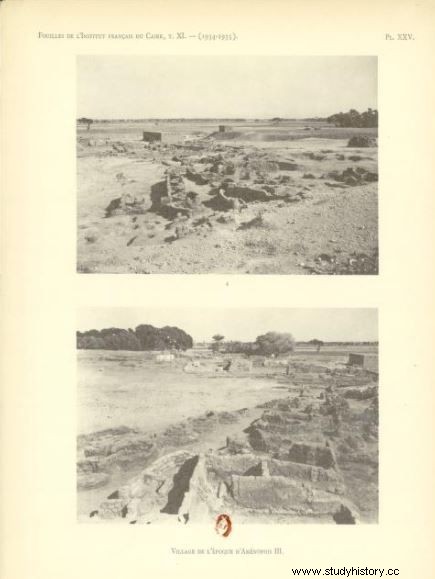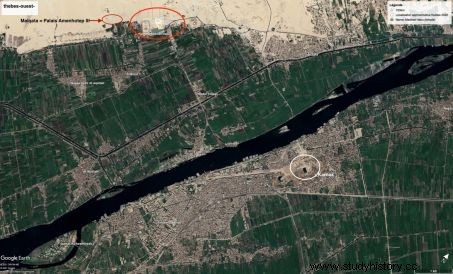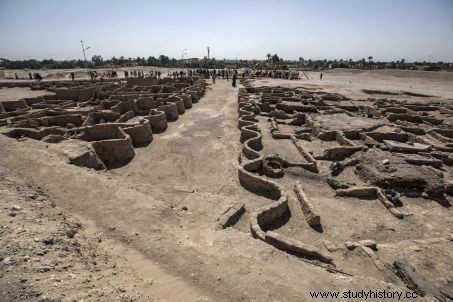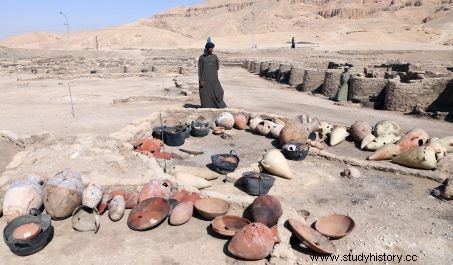The recent announcement of a major archaeological discovery in the ancient cities of Thebes, Egypt, may not be that of a "lost city" , as proclaimed, but rather installations related to the city-palace of Amenhotep III. A nevertheless important discovery that could shed new light on the first years of the reign of his son, the “heretic pharaoh” Akhenaten.

Workers uncovering 3,400-year-old pottery at a New Kingdom (18th Dynasty) site billed as "the largest ancient Egyptian city excavated to date".
The information has gone around the world! On Thursday April 8, 2021, the Egyptian authorities - through the voice of Zahi Hawass, former secretary then Minister of Antiquities - announced the discovery of a "lost city of gold" on the west bank of ancient Thebes, present-day Luxor. Like other media, Sciences et Avenir echoed what was then billed as "the largest ancient Egyptian city excavated to date …". However, the somewhat hyperbolic wording of the official press release left a number of Egyptologists dubious, who are now shedding more precise light on this event.
 A "lost city of gold" or the quarters of a village of artisans linked to an already known architectural complex? Credits:Egypt Luxor Archaeological Discovery
A "lost city of gold" or the quarters of a village of artisans linked to an already known architectural complex? Credits:Egypt Luxor Archaeological Discovery
If all agree in recognizing the importance of the discovery made near the temple of Medinet Habou, these specialists believe that the 3400-year-old remains exhumed could, rather than a “city” , concern developments linked to a well-known architectural complex:that of Malqata, the city-palace of Amenhotep III (1386-1353 BC), the father of Akhenaton (Amenhotep IV), ruler of the 18th dynasty.
"The exhumed remains are in fact in the continuity of a site excavated in 1935"
An opinion expressed by Egyptologist Christian E. Loeben of the August Kestner Museum in Hannover and the University of Göttingen (Germany) in an article published in the online magazine Spektrum.de . He is joined by French Egyptologist Robert Vergnieux, former director of the CNRS Archéovision Unit at the University of Bordeaux-Montaigne (Gironde), a great connoisseur of this major period in the history of ancient Egypt. Joined by Sciences et Avenir , this specialist in the constructions of Akhenaten and the site of Amarna - the capital that this sovereign had built 200 km away -, explains that his first doubts concerning a new "city" appeared with the publication of the photos of the unearthed corrugated brick walls. "The exhumed remains are in fact in the continuity of a site archaeological close excavated in 1935 by the French archaeologists Clément Robichon and Alexandre Varille (IFAO), whose archives can be consulted at the Department of Egyptology of the University of Milan (Italy)".
 Delineation of the 2021 excavations carried out in Thebes under the direction of Zahi Hawass (white outline), in relation at the site excavated in 1935/1936 by the French Robichon and Varille (in yellow). Also placed on this sketch are the remains of the nearby temples of Aÿ and Horemheb (Akhenaton's successors), as well as that of Medinet Habou (Ramses III). At the end of the Robichon and Varille plan of 1935 (the temple of the architect Amenhotep son of Hapu), there are already corrugated walls. Credits:Robert Vergnieux for Science and Future.
Delineation of the 2021 excavations carried out in Thebes under the direction of Zahi Hawass (white outline), in relation at the site excavated in 1935/1936 by the French Robichon and Varille (in yellow). Also placed on this sketch are the remains of the nearby temples of Aÿ and Horemheb (Akhenaton's successors), as well as that of Medinet Habou (Ramses III). At the end of the Robichon and Varille plan of 1935 (the temple of the architect Amenhotep son of Hapu), there are already corrugated walls. Credits:Robert Vergnieux for Science and Future.
 Archival photos from the 1935 excavations by Clément Robichon and Alexandre Varille of the "Temple of Amenhotep son of Hapu", (the royal architect of Amenhotep III), where you can see (above) a stretch of undulating walls.
Archival photos from the 1935 excavations by Clément Robichon and Alexandre Varille of the "Temple of Amenhotep son of Hapu", (the royal architect of Amenhotep III), where you can see (above) a stretch of undulating walls.
An undeniable link with Pharaoh Amenhotep III
According to Egyptologist Zahi Hawass, it was while researching the funerary temple of Tutankhamun that he discovered these new remains between the temples of Amenhotep III and the million-year-old castle of Ramses III, at Medinet Habu. The seals of clay and bricks stamped with the cartouche of Amenhotep III collected, attest well, without the slightest doubt, to a link between this discovery and the pharaoh of the New Kingdom. "Precisely because they are in the immediate vicinity of the palace of Amenhotep III [in Malqata Editor’s note], that these recently unearthed sectors could be the living quarters of the staff and craftsmen dedicated to its maintenance. This would explain the presence of workshops, kitchens, and bakeries" , says German Egyptologist Christian E. Loeben. Name of a "lost city".
 Map of Luxor, ancient Thebes, with the location (large red circle) of the current area excavated in 2021, in relation to the various bordering temples, and the palace-city of Amenhotep III - Malqata (small red circle). On the east bank of the Nile, the site of Karnak (white circle). Credits:Robert Vergnieux for Science and Future.
Map of Luxor, ancient Thebes, with the location (large red circle) of the current area excavated in 2021, in relation to the various bordering temples, and the palace-city of Amenhotep III - Malqata (small red circle). On the east bank of the Nile, the site of Karnak (white circle). Credits:Robert Vergnieux for Science and Future.
"Be that as it may, these remains are no less remarkable", tempers Robert Vergnieux. They are indeed associated with a particularly fascinating moment in ancient Egyptian history known as the Proto-Amarna Episode. Either the end of the reign of Amenhotep III and the advent of that of his son Akhenaten, before the latter abandoned Thebes, to settle in Akhetaten, the current Amarna. "The pharaoh had this city built from scratch in the middle of the desert after s to have proclaimed the solar disc Ankh-Rê-Horakhty-Aton sole deity of his new cult" , continues Robert Vergnieux.
 Remains of 3400-year-old corrugated walls contemporaneous with the reign of Amenhotep III excavated in 2020/2021 on the western shore of ancient Thebes. Credits:Khaled Desouki/AFP
Remains of 3400-year-old corrugated walls contemporaneous with the reign of Amenhotep III excavated in 2020/2021 on the western shore of ancient Thebes. Credits:Khaled Desouki/AFP
"A delight for any archaeologist"
"The corrugated walls unearthed in the excavations of 1935 and 2021 are of rare and very specific shapes . There are also similar ones east of Karnak, on the other bank of the Nile, which are represented on Talatats (engraved blocks) on the walls of the temple that Amenhotep IV/AKhenaton had erected to the god Aten. Karnak, where he revolutionized the religious balance of Egyptian society and the place occupied by the pharaoh. We are in fact with these discoveries on a site contemporary with the transition to the Amarna period . Finding vestiges still in place of the neighborhoods inhabited by the people who were actors in these episodes of Egyptian history is a joy for any Egyptologist!" .
 Pottery and corrugated walls, the extraordinary state of preservation of an 18th dynasty site. Credits:Stringer/Anadolu Agency/AFP
Pottery and corrugated walls, the extraordinary state of preservation of an 18th dynasty site. Credits:Stringer/Anadolu Agency/AFP
This discovery could shed light on unknown aspects of the life of the cursed king Akhenaten. It should be remembered that on his death, all his buildings were destroyed and his name rejected from the official royal lists. These new excavations could help document his early years of which so little is known and the time of his departure for Amarna, as well as the return to Thebes of his successors.
